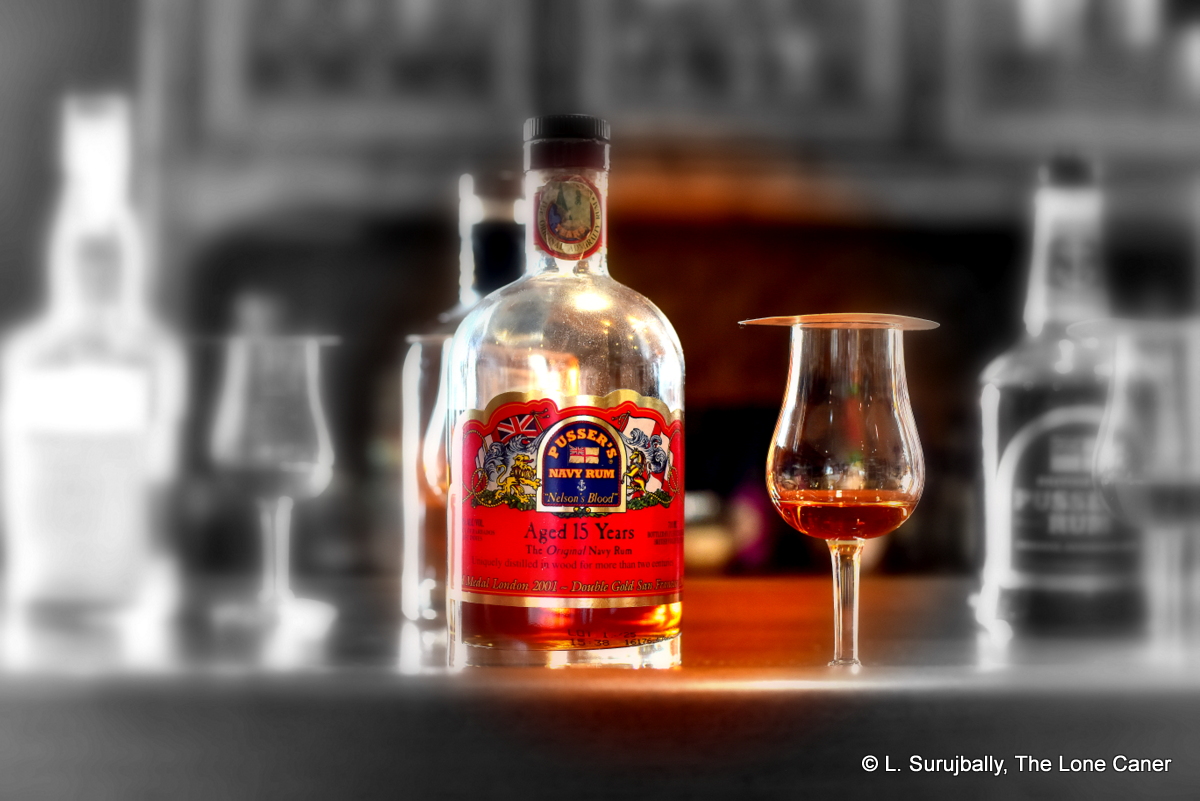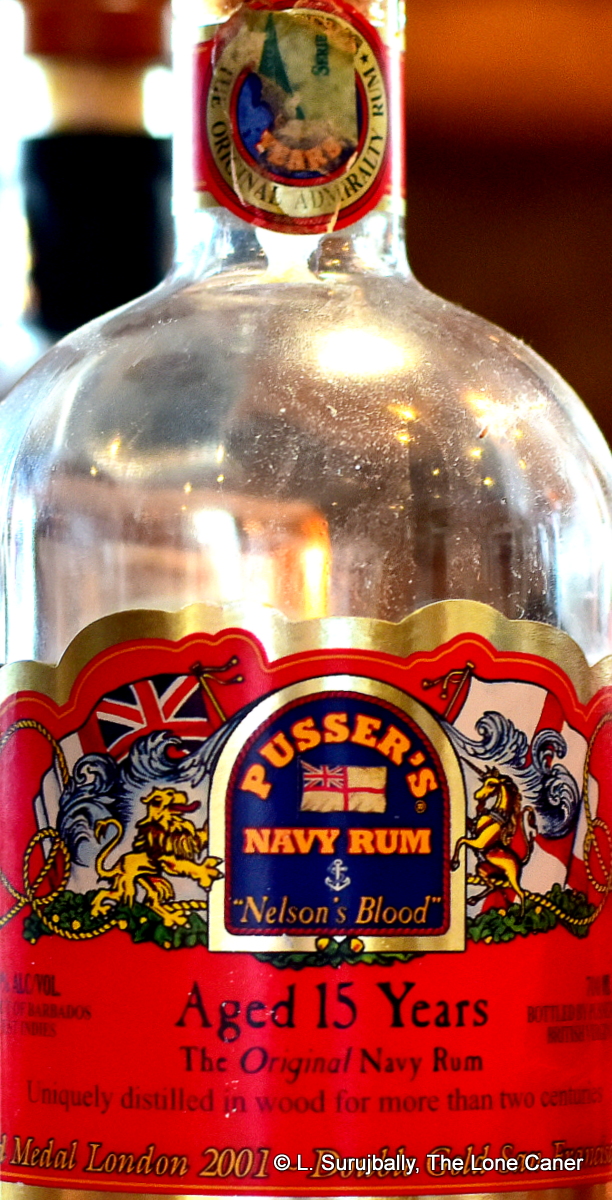
When you really get down to it, Pusser’s claim to fame rests on two main planks. The first is that it is they are the true inheritors of the actual British Navy rum recipe after Black Tot Day in 1970. The second is that they follow it.
Unfortunately, neither is completely true, depending on how you look at the background.
With respect to the first point, any research done on Navy rums shows that Lyman Hart, Lamb’s and ED&F Man, among others, sold rums to the Royal Navy back in the 1800s (Man became the major supplier in the 1900s, though I don’t think they were the sole source even then), and it is highly unlikely they were consistent in what they provided. Moreover, the rum (from whatever source) was always a blend, and the components did not stay rock solid stable for centuries. In fact, according to the booklet about the Black Tot accompanying the bottle and written by Dave Broom, the Navy rum of the 1940s had been a complex blend – kind of solera – and over the centuries the Jamaican component had continually been reduced because of its funky taste which sailors did not like. Moreover there’s that modern tested-for adulteration of Pusser’s — 29 g/L additives by some estimates — which surely was not part of the original recipe no matter who made it.
Secondly, the very fact that the recipe was tweaked more than once — as recently as 2008 it was supposedly a blend of five West Indian rums — shows up the fallacy of completely buying into the idea this is a true heritage rum: it’s hardly an inheritor of a tradition that once included Guyanese, Jamaican, Trini and maybe even Bajan rums, which progressively got reduced down to Guyana and Trini components, and now is Guyana only. Even by 2018, one could taste that the blend was favouring Guyanese distillate and that might taste good, but wasn’t exactly the Royal Navy recipe now, was it?
So, strictly speaking, neither statement holds water. The Gunpowder Proof Black Label is probably closer to the way navy rums used to be made, but yet somehow, in spite of all that, it’s the 15 YO which people remember, which they refer to as one of the touchstones of their early drinking experiences. The thing is utterly unkillable and regularly turns up on the various Facebook fora with delighted chirps and snazzy photographs and the pride of some person who has either bought one for the first time, or tried it for the first time. It is also one of the most reviewed of the entire Pusser’s line, with just about every writer sooner or later passing by to talk about it (see here, here, here, here, here, and here for some examples, almost universally positive)
 And why shouldn’t they? It’s a fifteen year old rum issued at a relatively affordable price, and is widely available, has been around for decades and has decent flavour chops for those who don’t have the interest or the coin for the limited edition independents.
And why shouldn’t they? It’s a fifteen year old rum issued at a relatively affordable price, and is widely available, has been around for decades and has decent flavour chops for those who don’t have the interest or the coin for the limited edition independents.
So what was it like? The tasting notes below reflect the blend as it was in April 2018, and this is different to both the initial rum I tried back in 2011 and again in 2019 when the “new and improved” Guyana-only blend crossed my path.
The nose, for example, certainly has lots of stationery: ruber, pencil erasers, pencil shavings. Also sawdust, citrus, lumber – reminds me a lot of the Port Mourant or Versailles distillate, if a little dumbed down. After some time, molasses crept timidly out the back end with caramel, toffee, ginger and vanilla hiding in its skirts, but their overall reticence was something of a surprise given my tasting memories — I seem to recall them as much more forward. Blame it on increasing age, I guess – mine, not the rum’s.
By the time it got around to tasting, the Guyanese component of the blend was much more evident, definitely favouring the wooden pot stills’ aggressive taste profiles. Glue, rubber, nail polish, varnish were the tastes most clearly discernible at the inception, followed by bitter chocolate and damp sawdust from freshly sawn lumber. It’s beneath that that it shines even at the paltry strength – creme brulee, warm caramel dribbled over vanilla ice cream, coffee and molasses, with just a hint of dark fruits (raisins, plums) and indistinct floral notes tidying things up. The finish, as is normal for standard proof spirits, is fairly short but nicely rounded, summarizing the aforementioned tastes and smells – caramel, vanilla, flowers, ginger, anise, raisins, dark fruits and pineapple for the most part. The added whatever-it-is makes it sweet and nicely rounded and a decent sip – non-rum-junkies would likely find favour with that, while deep-diving rum chums would equally sniff and say it’s over-sweetened and dampened down, with the good notes being obscured.
Well, each to his own, I guess. My notes here aren’t going to change anyone’s mind. At the end of it all, it is a tasty all-round rum for most, which survives in people’s tasting memories in spite of its adulteration, and constantly gains new (young) acolytes because of it. My own opinion is that while Pusser’s sells well, its glory days are behind it. It has not maintained the core blend, being forced by market pressures to simplify the components rather than keep them in play. They have extended their line over the years to add to the stable with the gunpowder proof, various strengths and other iterations, spiced versions and this to some extent dilutes the brand, good as they may all be.
So why do I call this a key rum? Because it is a good rum which should be remembered and appreciated; because it hewed and hews as close to the line of the old navy rums as we’re ever likely to get; because it’s 15 years old and still affordable; and because for all its blended nature and therefore indeterminate origins, it’s just a well-made, well-aged product with a whiff of true historical pedigree and naval heritage behind it. Even now, so many rums down the road, I remember why I liked it in the first place.
And aside from all that, even if you don’t buy into my premise, and dislike the brand dilution (or expansion), and even with all the competition, Pussers still has a lustre and brand awareness that can’t be shrugged off. Almost all bloggers sooner or later pass by and check it out, some more than once. It is a milestone marker on anyone’s journey down the myriad highways of rum. It remains relevant because no matter how many pretenders to the throne there are, this one company supposedly does actually have the (or an) original recipe for the navy rum, and if they chose to change it over time, well, okay. But the 15 year old remains one of the core rums of the lineup, one of the best they made and make, and nobody who tries it as part of their education, is ever likely to completely put it out of their minds, no matter how far past it they end up walking to other milestones down the road.
(#627)(83/100)
This first is just housekeeping, but if all the “here”s were meant to be links to blog posts they were inoperative as of this time. In regard to the review, you might have saved me a few bucks, because I think I’ll stay with the ED15, which always costs at least $10US less where I shop. The all Guyana 2019 will attract some looking for reduced sweetening but again, for me ED8.
But for the reasons you outlined this belongs with the Key Rums; and this has been an interesting read, as always. Cheers.
Fixed all the “here” links, thanks.
Bonjour,
Je voudrais savoir si vous avez eu l’occasion de déguster le Rhum Pusser Nelson’s blood rare année 80 et si oui pouvez vous m’en dire plus sur ce rhum.
Hello,
I would like to know if you had the opportunity to taste the Pusser Nelson’s Blood rare rum (from the) year 80 and if so can you tell me more about this rum.
Sorry, no, I have not tried it.
Désolé, non, je n’ai pas essayé.